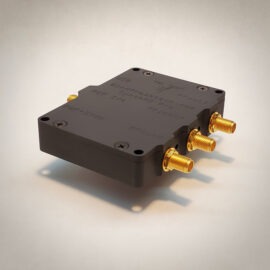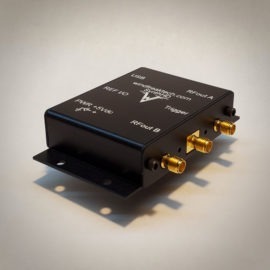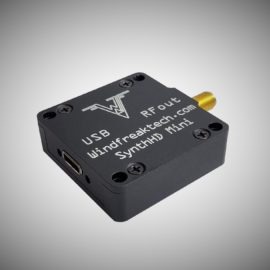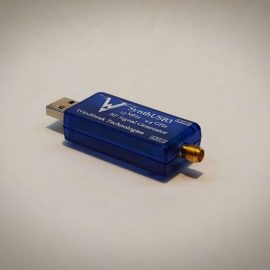Radio Frequency Signal Generator
Why Buy Our RF Signal Generators?
Windfreak Technologies’ RF signal generators are designed to emphasize reliability, low cost, and small size without sacrificing features like
- High calibrated RF power
- Great phase noise
- Modulations
- RF sweeping
- RF hopping
- Hardware triggering
- UART control
- And more
For over a decade, our RF signal generators have been routinely used in place of large benchtop products by Keysight, Rohde & Schwarz, and other high-cost competitors.
Our signal generators have been implemented by major corporations, small companies, startups, universities, contractors, militaries, and government agencies around the globe.
They are used anywhere engineers, technicians, or scientists might need an RF Signal Generator for either experimentation or production of high volume equipment.
The spectrum of applications ranges from wireless communications devices and automated test equipment to quantum computing experimentation and production.
In-Stock Products and Expert Support
We pride ourselves on keeping products in stock and shipping within just a few business days. We support customers after the sale by providing responsive US-based technical support and a 90 day “no questions asked” return policy.
Find a Signal Generator for your Needs
With a solid reputation in the industry, these signal generators offer consistent and stable performance, internal operating within a wide temperature range of -40°C to +85°C (-40°F to +185°F), making them a trusted choice for various applications. The robust design and high-quality components ensure reliable signal generation, minimizing signal drift and fluctuations. Shop our products below. See how we test our RF signal generators for reliability.
RF Signal Generator Features
- AM, FM, & Pulse Modulation
- High Amplitude Resolution
- Dual Channels
- Reference Input & Output
- Factory Amplitude Calibrations
- Frequency & Amplitude Hop Tables
- Wide Frequency Range
- High Frequency Resolution
- Frequency Sweeping
- Low Harmonic Distortion
- Local Oscillator Signal Generation
- Wide Operating Temperature
- Low Phase Noise
- Pulsed FMCW Chirp Signals
- High RF Output Power
- RF Phase Adjustable
- High RF Port to Port Isolation
- Signal Generation
- Multiple Concurrent Signal Modulations
- GUI Software Source Code Provided
- Trigger Input
- UART Control
- Upconversion & Downconversion
- USB Control
- Phase Locked Loop
RF Signal Generator Product Comparison
| SynthUSB3 | SynthHD Mini | SynthHD | SynthHD Pro | |
|---|---|---|---|---|
| MSRP (USD) | $399 | $1299 | $1999 | $2999 |
| Device Type | RF Source | RF Source | Dual Channel RF Source | Dual Channel RF Source |
| Number of Channels | 1 | 1 | 2 | 2 |
| Phase Adjustable | Yes | Yes | ||
| Min RF Frequency | 12.5 MHz | 10 MHz | 10 MHz | 10 MHz |
| Max RF Frequency | 6.4 GHz | 15 GHz | 15 GHz | 24 GHz |
| Frequency Resolution | 0.01 Hz | 0.01 Hz | 0.01 Hz | 0.01 Hz |
| Min Output Power | -40 dBm | -20 dBm | -50 dBm | -50 dBm |
| Max Output Power | 8 dBm | 20 dBm | 19 dBm | 19 dBm |
| Amplitude Resolution | 0.2 dB* | 0.01 dB | 0.01 dB | 0.01 dB |
| Factory Calibration | Yes | Yes | Yes | Yes |
| Modulation | AM, FM, Pulse | AM, FM, Pulse | AM, FM, Pulse | AM, FM, Pulse |
| External Modulation | Yes | Yes | Yes | Yes |
| Active Mixer | ||||
| RF Power Detector | ||||
| Trigger Input | Yes | Yes | Yes | Yes |
| UART Control | Yes | Yes | Yes | Yes |
| External Reference | Yes | Yes | Yes | Yes |
| Internal Reference | 27 MHz | 27 MHz | 10 MHz 27 MHz | 10 MHz 27 MHz |
| 1 GHz Phase Noise @ 10KHz Offset | -115 dBc/Hz | -114 dBc/Hz | -114 dBc/Hz | -114 dBc/Hz |
| Product Information | SynthUSB3 | SynthHD Mini | SynthHD | SynthHD Pro |
Frequently Asked Questions
How does an RF generator work?
An RF Generator creates radio frequency signals using high speed voltage controlled oscillator (VCO) circuits combined inside a phase locked loop (PLL). The VCO oscillates and makes an RF signal that is tuned in frequency by a control voltage. A VCO will drift in frequency and have significant noise called phase noise if it is not nicely controlled. This is the job of the PLL. The PLL is a control system that measures the phase (and frequency) of the VCO while concurrently adjusting the voltage of the VCO so that frequency stability is achieved. The frequency stability is determined by the reference frequency (Fref), which usually comes from a lower frequency crystal based oscillator.
What is an AF and RF signal?
RF stands for Radio Frequency, which is a signal that propagates through the electromagnetic field around us. AF stands for Audio Frequency which propagates through the air molecules around us. Audio frequency refers generally to the frequency band that our ears can hear which is usually considered 20 Hz through 20,000 Hz. The RF frequency band is generally considered to be 3,000 Hz up to 300 GHz (300 with nine zeros). While 3 KHz up to 20 KHz is considered part of the audio frequency band, it can also be carried in the electromagnetic field and transmitted as RF! This usually requires a very long antenna. In both cases AF and RF can, of course, be carried on a wire.
What is the basic difference between AF signal generator & RF signal generator?
An AF Signal Generator is a low frequency generator and an RF Signal Generator generates much higher frequencies. While circuits in an AF Generator can be somewhat complex, RF Signal Generators can be very complex.
What are the different types of signal generator?
There are a few different types of signal generators.
- PLL based RF Signal Generator. These cover very large frequency ranges and have been discussed above.
- DDS based Signal Generators. These are Direct Digitally Synthesized devices that can be very clean and agile. Unfortunately they can become cost prohibitive much above 1GHz and use quite a bit of current.
- Arbitrary Waveform Generators. These can generate very complicated signals across the RF spectrum. They can be expensive and require expertise to operate. Usually the consist of a baseband
- IQ modulator combined with a radio up-converter.
Waveform Generator. These devices frequency ranges usually cover 20Hz to many Megahertz, are lower cost and will usually create time domain waveforms in the shape of sinusoids, square waves, triangles and saw tooth waveforms.
Is RF AC or DC?
RF is AC, or Alternating Current. It usually has a periodicity, which means its voltage and current cycle (alternate) at or around particular frequency. DC, or Direct Current has no variation, or at lease has no periodicity. DC usually refers to a specific voltage, such as the 1.5Vdc that comes from a traditional alkaline AA battery.
What are the warranty and support options available for the RF signal generator
We support customers after the sale by providing responsive US-based technical support and a 90 day “no questions asked” return policy.






